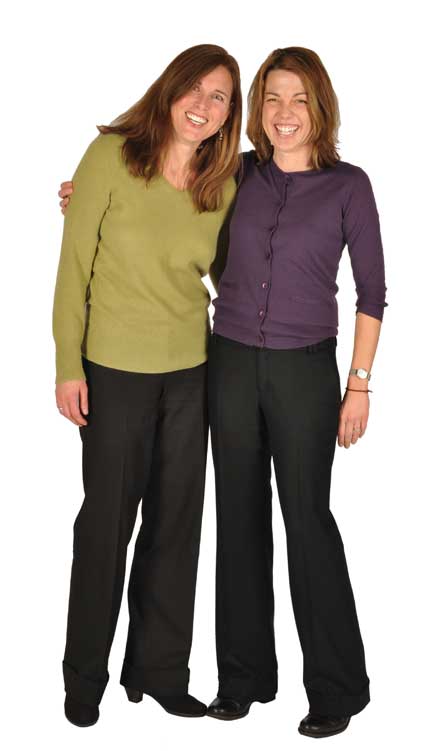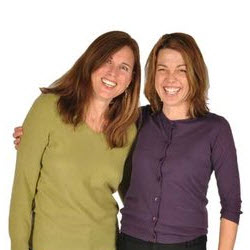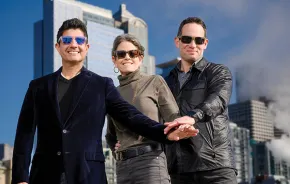Meredith Lohr and Kim Armstrong are the co-executive directors for Washington Green Schools (WAGS). Before forming a nonprofit for the program, they served as consultants for WAGS. They also collaborate with Sound Footprint, which serves schools and organizations working toward a sustainable future. Lohr (pictured right) has a bachelor of science degree in environmental science and a master of science in earth sciences. Armstrong (left) holds a bachelor’s degree in economics and an M.B.A.
 Why should readers pay special attention to Washington Green Schools?
Why should readers pay special attention to Washington Green Schools?
Armstrong: We’re helping guide the next generation of environmental stewards. As a nonprofit program supported by government agencies, individuals, businesses and foundations, Washington Green Schools (WAGS) is impacting hundreds of schools, teachers, and thousands of kids and families by effectively teaching, modeling and then practicing sustainability.
You’re an environmental dynamic duo. Share the origins of your mission that drives the positive impact you and Washington Green Schools are now having.
Lohr: Kim and I met about five years ago at Bertschi School, which is very focused on sustainability. I had come from Maryland to Seattle and fell in love with this environment, and wanted to get other people excited about it. I started to engage in environmental education and created curriculum around that passion.
Of the work you are doing with Washington Green Schools, what makes each of you proudest?
Armstrong: Washington Green Schools is a way for teachers to help their students understand and master the standards around sustainability. When each school submits their process, we hear inspired stories about how engaged the kids are by reducing their school’s garbage pickup. We all see real results.
When we do workshops to train teachers, they express gratitude and excitement that inspires us. We reach hundreds of kids — over 100,000 kids to date. Teachers let us know that this education has students more engaged in math, science and writing as they practice their skills in the context of helping the earth.
Lohr: The collective impact of over 200 schools in the program equates to measurable and sustainable environmental change. Climate change is the grand environmental issue of our time. We see that we are able to help schools, students and families reduce their carbon imprint by reducing energy use for home, school buildings and transportation. Taking some type of action and committing to that is a great first step that saves money and costs zero to implement.
What non-green behavior drives you crazy — and what can be done about it?
Armstrong: Cars idling in front of schools. (Turn your car off, please!) Turn the thermostat down, shut appliances off and unplug them when they are not in use, and walk, don’t drive, whenever possible.
Also, asthma is a leading cause of school absenteeism. In fact, 12.8 million school days were missed due to the disease in 2003. Because it’s linked to indoor and outdoor air quality, schools can help reduce this number by cleaning the rugs, improving vent filtration and using nontoxic cleaning supplies.
If you were to suggest that families invest beyond the zero-cost actions you’ve proposed, what would be at the top of your list?
Lohr: Dual flush toilets, hybrid cars and appliances labeled with “energy star” because they reduce greenhouse gas emissions and other pollutants caused by the inefficient use of energy. A new dishwasher can save thousands of gallons of water a year. In addition, I’d say, buy organic food in bulk and learn about TerraPass, a carbon offset provider (terrapass.com).
What are the biggest barriers to a school’s ability to be green?
Lohr: Schools are in the midst of terrible budget times with overcrowded classrooms. Teachers are worried about test scores; just the idea of something new is met with resistance. Once a superintendent or teacher sees that Washington Green Schools can help them and their students address real-world situations, learn academic disciplines and save money allowing much needed funds to go back into programs, we’re in!
Washington Green Schools program at a glance:
Participating schools: 200
Level 1 schools: 39
Level 2 schools: 9
Level 3 school: 1
Participating districts: 65
Students attending participating schools: 101,334
Participating counties: 22



 Meredith Lohr and Kim Armstrong are the co-executive directors for Washington Green Schools (WAGS). Before forming a nonprofit for the program, they served as consultants for WAGS. They also collaborate with Sound Footprint, which serves schools and organizations working toward a sustainable future. Lohr (pictured right) has a bachelor of science degree in environmental science and a master of science in earth sciences. Armstrong (left) holds a bachelor’s degree in economics and an M.B.A.
Meredith Lohr and Kim Armstrong are the co-executive directors for Washington Green Schools (WAGS). Before forming a nonprofit for the program, they served as consultants for WAGS. They also collaborate with Sound Footprint, which serves schools and organizations working toward a sustainable future. Lohr (pictured right) has a bachelor of science degree in environmental science and a master of science in earth sciences. Armstrong (left) holds a bachelor’s degree in economics and an M.B.A.





